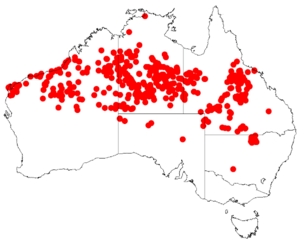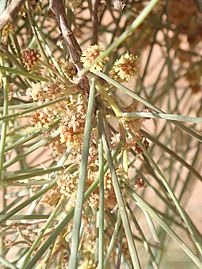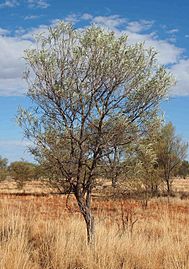Acacia sericophylla facts for kids
Quick facts for kids Acacia sericophylla |
|
|---|---|
 |
|
| Scientific classification | |
| Genus: |
Acacia
|
| Species: |
sericophylla
|
 |
|
| Occurrence data from AVH | |
| Synonyms | |
|
Racosperma coriaceum subsp. sericophyllum (F.Muell.) Pedley |
|
Acacia sericophylla is a type of shrub or tree. It's often called the desert dogwood, desert oak, or cork-bark wattle. The Nyangumarta people, who are Indigenous Australians from the Pilbara region, call this plant Pirrkala. This plant belongs to the Acacia group, which is a large family of plants.
Contents
What Does it Look Like?
This plant is usually a twisted or knotty shrub or tree. It typically grows about 2 to 6 metres (7 to 20 ft) tall. But in Queensland, it can reach up to 10 m (33 ft) high. It often has one main stem or a few big stems at its base. This helps it grow back after bushfires.
The bark is thick and spongy. It's grey to black and has long cracks running down it. Underneath, the bark is yellow and spongy. Its small branches are easy to break. When they are young, they have fine, silvery hairs. As they get older, they become smooth (this is called glabrous).
Like most Acacia plants, it doesn't have true leaves. Instead, it has special leaf-like parts called phyllodes. These phyllodes are silvery grey-green. They grow in bunches at the ends of the branches. They look long, narrow, and strap-like. They are flat and measure 12 to 35 cm (4.7 to 13.8 in) long and 1 to 7 mm (0.039 to 0.276 in) wide. They feel a bit stiff and leathery.
The phyllodes can grow straight or curve backwards. When they are young, they are covered in fine, silky hairs. As they get older, they become mostly smooth. They have many thin, parallel lines running along them.
How it Was Named and Classified
In 1859, a scientist named Ferdinand von Mueller first described this plant. He gave it the scientific name Acacia sericophylla. Later, in 1993, two other scientists, Richard Sumner Cowan and Bruce Maslin, thought it was a type of Acacia coriacea. So, they called it Acacia coriacea subspecies sericophylla.
However, the main group that checks plant names in Australia, called the Australian Plant Census, decided in 2006 that it should go back to its original name, Acacia sericophylla. This is the name used today.
Meaning of its Name
The second part of the plant's scientific name, sericophylla, comes from two ancient Greek words.
- Sericos means "silken."
- Phyllon means "leaf."
This name refers to the dense, silky hairs found on the plant's young phyllodes.
Where it Grows
This plant naturally grows in several parts of Australia. You can find it in the Northern Territory. It also grows in the Kimberley and Pilbara regions of Western Australia. You might also see it in New South Wales and South Australia.
Gallery




